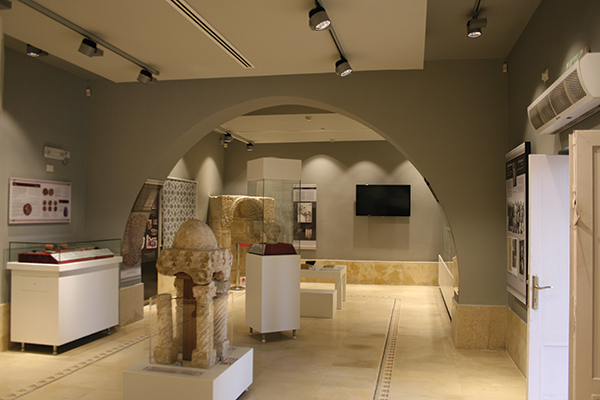The Site Museum at the archaeological park of Hisham’s Palace at Khirbet al-Mafjar in Jericho was opened in May 2014. The museum displays the history and archaeology of the Umayyad site of Khirbet al-Mafjar, identified with Hisham’s Palace (Qasr Hisham) in the Jordan Valley. The site is attributed to Caliph Hisham ibn Abd al-Malik (724–743 AD) on the basis of some epigraphic materials. The palace was destroyed in a severe earthquake in 748/749 AD. The palatial complex is composed of the palace, a thermal bath, a mosque, and a monumental fountain within a perimeter wall. The three main buildings were arranged along the west side of a common forecourt, with a fountain pavilion in its center. The palace was originally a two-story building with round towers at the corners. It features a spectacular example of early Arab architecture, with its rich mosaics, stucco decoration, and sculpture.
 The small museum displays around 150 objects from the site of Khirbet al-Mafjar; most of the artifacts were found during the excavation conducted by Dimitri Baramki and Robert W. Hamilton in 1934–1946, and supplemented by more recent discoveries from the joint Palestinian-American excavation conducted between 2006 and 2014 by the Palestinian Department of Antiquities and Cultural Heritage and the Oriental Institute at University of Chicago, under the direction of Hamdan Taha and Donald Whitcomb. The excavation also revealed a large part of the northern gate of the palace and a large enclosure with fine masonry of the Umayyad period and a walled settlement of the subsequent Abbasid period, indicating an agricultural estate (day’a) contemporary with the palace.
The small museum displays around 150 objects from the site of Khirbet al-Mafjar; most of the artifacts were found during the excavation conducted by Dimitri Baramki and Robert W. Hamilton in 1934–1946, and supplemented by more recent discoveries from the joint Palestinian-American excavation conducted between 2006 and 2014 by the Palestinian Department of Antiquities and Cultural Heritage and the Oriental Institute at University of Chicago, under the direction of Hamdan Taha and Donald Whitcomb. The excavation also revealed a large part of the northern gate of the palace and a large enclosure with fine masonry of the Umayyad period and a walled settlement of the subsequent Abbasid period, indicating an agricultural estate (day’a) contemporary with the palace.
The museum presents archaeological artifacts, architectural elements, and stucco decoration, providing a range of information to visitors about the rich history of the site and the various aspects of daily life in the Umayyad palace and the adjacent agricultural estate. In addition, the museum contains several interpretation panels that cover different subjects related to the site and its history: material culture, including ceramics, glass, and coins; agriculture; and other subjects related to the architecture of the palace and the traditions associated with it. A panel is also dedicated to the Palestinian archaeologist Dimitri Baramki and his work on the excavation of Hisham’s Palace between 1934 and 1946. Additional interpretation panels were installed throughout the archaeological park to enhance the experience of the visitors and help form a better understanding of the site.
The museum also offers a short film about the history of the site, including its evolution and destruction, and sheds light on the past and most recent excavations. It also presents a unique reconstruction of the palace and some spectacular views of its mosaics, including that of the audience hall, which are currently covered for protective purposes.
The museum and archaeological park are open daily from 8:00 to 17:00, including weekends and holidays.


